2023 Nissan Ariya Vs 2023 Ford Mustang Mach-E

Nissan was one of the first brands to make a mainstream all-electric vehicle with the LEAF. But when it comes to the booming electric SUV segment, Nissan is a bit late on arrival. Finally, the brand has jumped in with the all-new Ariya.
To see if Nissan’s new EV SUV is any good, we’ve set up another AutoGuide comparison brought to you by WeatherTech. In this head-to-head we’re comparing the Ariya to one of the most established competitors in the market, the Ford Mustang Mach-E. Similar on paper, we found the two EVs are quite different in reality. Let’s take a deeper look at both vehicles.
Ford Mustang Mach-E
Having been on sale for three years, Ford is constantly updating the Mustang Mach-E to make it better. With new competition arriving all the time, like the Ariya, the brand can’t sit back and be complacent.
Currently, the Mach-E can be had with rear- or all-wheel drive, and a choice of three battery sizes as well as multiple power levels. The lowest powered Mach-E’s have 226 hp and 316 pound feet of torque while the most powerful, the Mach-E GT, recieves 480 hp and 634 lb-ft.
Our Premium test vehicle has the dual motor all-wheel drive system with 346 horsepower and 428 pound feet of thrust. Ford claims this model can go from 0 to 60 mph in less than five seconds. Yeah, electric SUVs are fast, even in middle-trim.
Real World Power and Range
As the numbers suggest, power is plentiful in any situation. The vehicle never feels like it’s lacking power even at the highest freeway speed limits. Honestly, it’s more power than anyone will ever need. Sure, we always want more power, but here, more power isn’t needed.
Keeping our Mach-E tester running is the largest battery option, measuring in at 91 kWh. This gives the vehicle an official range of 290 miles between charges. That’s on the higher end of the Mach-E’s range or driving ranges, which is between 224 miles to 312 miles, depending on how the Mustang is configured. During our mixed driving, we got similar range numbers on a nice summer day.
When the Ford’s big battery does run out, it can recharge at speeds up to 150 kW. Although that’s not the highest in the segment, it is more than the Ariya. Plus, only the most powerful level three chargers run over 150 kW. Granted, more and more are being installed all the time.
Spacious, Well Equipped
The Mach-E’s cabin is one of the most spacious feeling in the segment. The large glass roof has a lot to do with this as it provides an open airy feel. We like how it curves upwards, so it doesn’t affect headroom for front or rear passengers. Full size adults easily fit in the back and shouldn’t complain about space or seat comfort. Outward visibility through the side windows is a bit cut off from this sloping roof though.
Up front, the seats are very comfortable with a cushiony feel that we sort of sink into. We like the cabins overall design with this massive 15.5-inch tablet screen and fabric inserts on the dashboard and speakers. The touch screen features just one button and large dial and although it’s easy enough to operate and navigate through the various menus, some tasks take too many steps to complete.
As should be expected of a higher trim model, the Mustang Mach-E comes well equipped. Included are that fixed glass roof, the massive screen, a smart liftgate, rain sensing wipers, a B&O audio system, wireless phone charging, and Ford’sBlueCruise 1.2. Oh, and unlike the Ariya, the Mach-E has a front trunk that’s quite useful.
Familiar, Yet Unconventional
For whatever reason, EVs need to be unconventional and weird, and this Ford has a few features that are unique. Look at the door handles inside and out. They’re some of the most unusual designs and although the exterior ones have yet to win us over, we do like the toggle-like interior handles.
The overall styling is also quirky with the stretched, enlarged Mustang pony car cues front and rear. It may not be everyone’s taste, but it too is growing on us.
Refined Drive
Another thing we like about the Mach-E is the overall refined feeling to the way it drives. Beside amble power, the vehicle is smooth on the road, isolating sound, and absorbing bumps. It’s also more composed through corners than the Ariya. The overall feel behind the wheel is solid and more premium.
The Mach-E continues to be an appealing mainstream all-electric SUV. It mixes, space, comfort, refinement, performance, and range in an attractive package. But is it better than the Ariya?
Nissan Ariya
The Ariya may look big on the outside, but it’s a bit of an optical illusion from the rounded, bubbly shape. The vehicle is actually a bit smaller than the brand’s own Rogue. Compared to the Mustang Mach-E, it’s not as long, but is wider and a bit taller. Inside, it feels larger than that.
This is achieved thanks to clever packaging that can only happen with electric vehicles. There is a nearly flat floor front and rear that gives amble legroom and an airy, van-like feeling. Although most interior dimension for head and legroom are smaller in the Ariya compared to the Mach-E, it’s hard to notice. The Nissan’s large windows, along with the panoramic sunroof, lets a lot of light inside. This vehicle definitely has the better rear seat for adult passengers, thanks mainly to the larger windows.
Style with Quirks
The front seats may not be quite as comfortable as the Ford’s, but they’re still a great place to spend a lot of time. Like the Mach-E, there are dual screens on the dashboard, measuring over 12-inches each. But unlike the Ford, there are also dual glove boxes and a somewhat-gimmicky power adjustable center console. The overall interior styling has a sophisticated flair with the curved dual screens, rose gold trim highlights, and the geometric ambient lighting.
We can’t review this EV without discussing the haptic controls built into the fake wood trim. We do like the look, and in practice, they mostly work as intended. Are they as functional as a push button? No, not at all. But they do look much cooler and more futuristic.
While on the topic of features, our tester also includes the around view monitor, a rear-view mirror camera, wireless phone charging, heated rear seats, wireless apple carplay and android auto, rain sensing wipers, head up display, and much more.
One feature the Ariya does trail the Mach-E on is cargo capacity. The rear cargo area is smaller and there is no front trunk on this vehicle.
Choice of Power
Like the Mustang Mach-E, the Ariya is available with various drivetrains and battery sizes. Unlike the Ford though, the Nissan is front wheel drive when opting for a single motor. Power ranges from a low of 214 hp and 221 pound feet of torque for the entry level front wheel drive model, up to 389 hp and 442 pound feet for the most powerful dual motor all-wheel drive Ariya. Except for the sporty Mach-E GT, this is closely matched to Ford’s all-electric SUV.
The largest battery, which is equipped in our test vehicle, comes in at 87 kWh. Being a slightly smaller battery compared to the Ford’s, it leads to lower overall range for the Ariya. Entry level vehicles can travel 205 miles between charges while the longest travelling Ariya’s are capable of 289 miles. As well, max charging speed for the Nissan is a bit lower with a maximum of 130 kW.
Feel Behind the Wheel
On the road, all-wheel drive Ariya’s have more than enough power for all driving situations. No surprise there as the power-to-weight ratio is very similar to the Ford’s. But even with just front wheel drive and the upgraded 238 hp motor, it’s deceivingly quick. It’s what was equipped in our tester, and we were quite impressed with its available acceleration, even at highway speeds.
Ride comfort is good and at least on par with the Mustang Mach-E. The Ariya is well sorted in terms of dynamics and controls. It accelerates, steers, and stops predictably, feeling more like a traditional SUV than the Ford. One quirk we did notice though has to do with braking. When coming to a complete stop, the Ariya rocks front to back a few more times than most other vehicles. It’s not a huge issue, just something that’s noticeable.
The Verdict: Nissan Ariya Vs Ford Mustang Mach-E
Pricing for the Ariya spans a big range depending on configuration. Apples to apples though, each configuration matches up closely with an equivalent Mustang Mach-E.
The two do differ in execution though. The Nissan Ariya shines is as a comfy, passengers-first EV SUV instead of one with a bit more performance edge. The Ford Mustang Mach-E is no slouch in the comfort and refinement department either though, it just includes a somewhat sportier feel.
Ultimately, both are compelling options in the rapidly growing and rapidly changing mainstream electric SUV segment. For our money though, we give the narrow victory to the Ford Mustang Mach-E.
Become an AutoGuide insider. Get the latest from the automotive world first by subscribing to our newsletter here.
Find everything you need for your car from WeatherTech.

A 20+ year industry veteran, Mike rejoins the AutoGuide team as the Managing Editor. He started his career at a young age working at dealerships, car rentals, and used car advertisers. He then found his true passion, automotive writing. After contributing to multiple websites for several years, he spent the next six years working at the head office of an automotive OEM, before returning back to the field he loves. He is a member of the Automobile Journalists Association of Canada (AJAC), and Midwest Automotive Media Association (MAMA). He's the recipient of a feature writing of the year award and multiple video of the year awards.
More by Mike Schlee



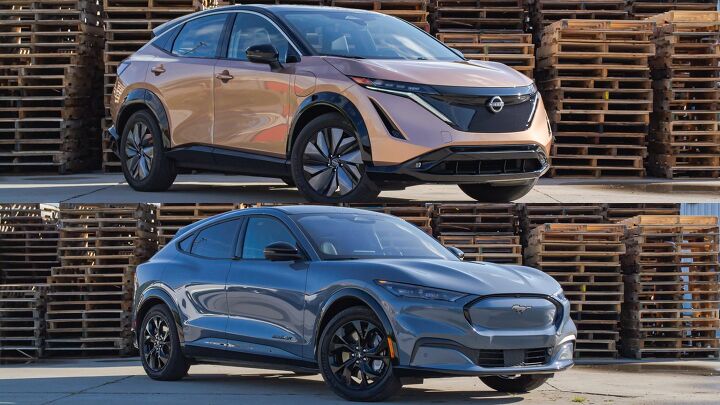
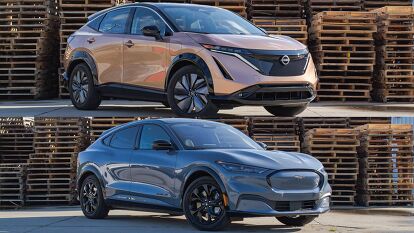






































































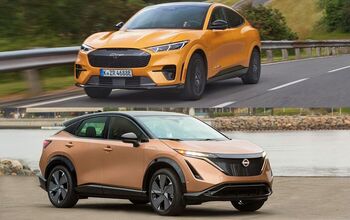
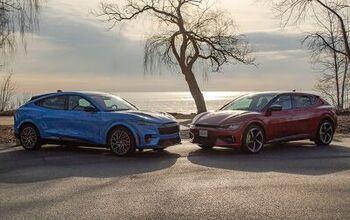
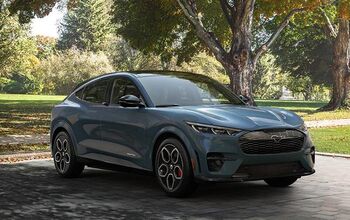














Comments
Join the conversation
Why is this comparison only with single motor? The S in SUV stands for Sport (skiing, sand beach, camping, kayaking, etc.) that requires AWD/dual motor, otherwise it is just a Utility Vehicle and not capable or worthy of consideration.
Why is this comparison only of single motor? The S in SUV stands for Sport (skiing, sand beach, kayaking, camping, etc.) that requires AWD/dual motor, otherwise it is incapable and not worth considering.